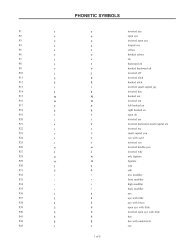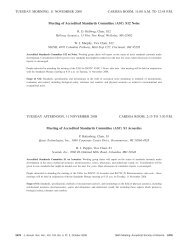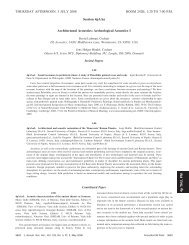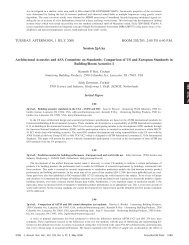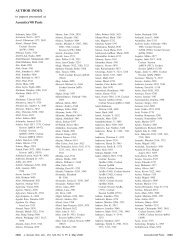Information for Contributors to JASA Express Letters - The Acoustical ...
Information for Contributors to JASA Express Letters - The Acoustical ...
Information for Contributors to JASA Express Letters - The Acoustical ...
Create successful ePaper yourself
Turn your PDF publications into a flip-book with our unique Google optimized e-Paper software.
2:1. Such figures fit the wide, single-column <strong>for</strong>mat of <strong>JASA</strong>-EL better than narrower figures (aspect ratios<br />
approximately 4:3) produced by the default settings of many common graphics packages. <strong>The</strong> latter, while<br />
well suited <strong>to</strong> regular <strong>JASA</strong>, result in substantial white space on each side of the figure in <strong>JASA</strong>-EL. If a<br />
nearly square figure is desired, authors should consider placing two such figures side-by-side and labeling<br />
them parts (a) and (b).<br />
<strong>JASA</strong>-EL will accept multimedia files (e.g., video and audio) as separate files. Specific instructions<br />
<strong>for</strong> submitting multimedia files are described in Section 6.4 below.<br />
6.3 Use of color and gray scales<br />
Color figures may be used when they convey in<strong>for</strong>mation difficult <strong>to</strong> portray in black and white or gray<br />
scale. To facilitate interpretation in black-and-white printed versions, lines on graphs should ordinarily be<br />
distinguished by different line styles or symbols. Authors should print their color figures in black and white<br />
<strong>to</strong> determine whether they remain intelligible. If interpretation of the figure is unclear in black and white,<br />
authors are expected <strong>to</strong> pay <strong>for</strong> color in the printed version. (See following paragraph.) Figure captions may<br />
refer <strong>to</strong> color only if the printed version appears in color.<br />
Color figures are published online without additional charge. Unless requested by the author(s),<br />
the color figures will be printed in gray scale in the printed version of <strong>JASA</strong>. If color printing is desired or<br />
necessary <strong>for</strong> interpretation of the figure, additional charges <strong>for</strong> color artwork in the printed edition of<br />
<strong>JASA</strong> will apply and payment is manda<strong>to</strong>ry. <strong>The</strong> charges incurred by inclusion of color figures in the print<br />
version of the Journal are difficult <strong>to</strong> estimate, and are determined by the printer on a case-by-case basis.<br />
<strong>The</strong>y may be as large as $1000 per page.<br />
6.4 Multimedia files<br />
A benefit of publishing in an online journal is the ability <strong>to</strong> integrate multimedia files in<strong>to</strong> both the<br />
published and archived articles. <strong>The</strong> online presentation of the paper allows <strong>for</strong> links <strong>to</strong> both audio and<br />
video clips directly from within the text of the article. <strong>The</strong> multimedia files submitted <strong>for</strong> <strong>JASA</strong> <strong>Express</strong><br />
<strong>Letters</strong> (<strong>JASA</strong>-EL) will be reviewed as part of the peer review process and accepted <strong>for</strong> publication in much<br />
the same way as are 2-dimensional figures <strong>for</strong> traditional print journals. <strong>The</strong> multimedia submission<br />
guidelines presented here are subject <strong>to</strong> change because of improvements and increasing availability of the<br />
relevant technology. Queries concerning the present status of the PXP system <strong>for</strong> submission of multimedia<br />
files can be addressed <strong>to</strong> jasael@aip.org.<br />
<strong>The</strong> implementation of <strong>JASA</strong>-EL on the Peer X-Press system is intended <strong>to</strong> be such that<br />
multimedia files are submitted in the same manner as are figure files, and that they are uploaded<br />
individually during the manuscript submission process. <strong>The</strong> sequence in which they are uploaded should be<br />
the same as that in which they are referred <strong>to</strong> in the text. <strong>The</strong> text should refer <strong>to</strong> these files using the<br />
designations Mm. 1, Mm. 2, etc.; this is similar <strong>to</strong> the convention of referring <strong>to</strong> figures as Fig. 1, Fig. 2, etc.<br />
To ensure broad viewing/playing ability across hardware plat<strong>for</strong>ms and browsers, submissions in a<br />
variety of file <strong>for</strong>mats are acceptable.<br />
Acceptable video <strong>for</strong>mats are: (i) QuickTime movies (mov); (ii) Mpeg movies (mpg);<br />
(iii) Animated Gifs (gif); (iv) Audio Video Interleave (avi)<br />
Acceptable audio <strong>for</strong>mats are: (i) AIFF (aif); (ii) Au (au); (iii) Wav (wav); (iv) Nonstreaming<br />
Real Audio (ra)<br />
In the above lists, the letters in parentheses are the standard endings <strong>for</strong> files in the corresponding<br />
<strong>for</strong>mat. For example, fancymovie.mov would be a file containing a QuickTime movie.<br />
It is important that authors make their multimedia files no larger or numerous than necessary <strong>to</strong><br />
convey scientific in<strong>for</strong>mation that is central <strong>to</strong> the manuscript's purpose. Authors should consider that files<br />
larger than several MB are problematic <strong>for</strong> readers using dial-up connections. Files larger than 10 MB<br />
require permission from the Edi<strong>to</strong>r. When video compression is used, the codec software module must be<br />
widely available. Files may not be compressed in<strong>to</strong> archives, such as .zip and .tar <strong>for</strong>mats. Since readers<br />
may find it tedious <strong>to</strong> download numerous files that contribute little new in<strong>for</strong>mation, authors must select<br />
their materials carefully. Submissions with more than 4 multimedia files must receive permission from the<br />
Edi<strong>to</strong>r.<br />
In the typesetting of an accepted manuscript, links will be placed within the online publication <strong>for</strong><br />
each of the multimedia files. During the peer-review process, the reviewers and edi<strong>to</strong>rs will access such<br />
files by going <strong>to</strong> the online site reserved <strong>for</strong> the submitted manuscript and its accompanying files, and then



